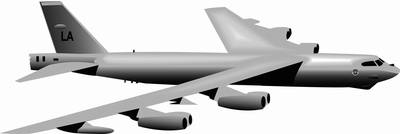Youth Springs Eternal—If The Dollars Don’t Run Out
Boeing’s B-52 Stratofortress is the world’s oldest, in-service, military aircraft. Affectionately referred to as BUFF (Big Ugly Fat F***ker) by the crews who fly it, the B-52 has existed in five iterations, designated A through H. Boeing built a total of 744 B-52s between 1952 and 1962, of which 76 remain in active service with the United States Air Force. With the possible exception of the 707-derivative KC-135, no aircraft in the USAF fleet has been so continuously and extensively modified, upgraded, and modernized as the B-52.

The Stratofortresses flying today are not the same machines came lumbering out of Boeing’s plants seventy years ago. Almost every bulkhead, spar, rib, stringer, and body-panel has been replaced—repeatedly. Systems, too—engines, hydraulics, pneumatics, environmentals, electrics, avionics, armament—have been changed out more often than Liberace’s wardrobe.
Now comes the next incarnation of the venerable Stratofortress, which depending on how pedantic Air Force brass inclines to wax, will be known as either the B-52J or B-52K. Col. Louis Ruscetta, senior materiel leader for the B-52 renovation program, asserts the new engines, engine pylons, avionics, and slick, fighter-style radar into which the USAF is fixing to slip the old girl represent the most ambitious and costly modification in the B-52’s long and glorious history.

The pseudo-straight-pipe Pratt & Whitney TF33-PW-103 engines by which the B-52 has been powered for the last six-decades are to be replaced by Rolls Royce’s F-130 turbofans. The new engines, while only marginally more powerful than the legacy P&W mills, meet the Air Force’s demands for higher bypass ratios, digital engine controls, and increased fuel-efficiency. If predictive models are correct—and they occasionally are—the new Rolls Royce engines will stretch the B-52’s 8,800-statute-mile range by up to forty-percent, giving the grand old dame a new un-refueled range of up to 12,320-statute-miles. Such legs are sufficiently long to project American air-power to any point on Earth.
For all the superlatives inspired by the B52’s new engines, the real excitement around the Pentagon pertains to the APG-79B4 radar with which the Stratofortress is to be kitted out. Col. Ruscetta describes the active, electronically-scanned array radar as a “game changer,” that will enable BUFF crews to scan farther, guide weapons in flight, improve mission situational awareness, and better operate with coalition partners. The APG-79 is effectively the same radar installed on the export version of Boeing’s F/A-18 fighter, with the array inverted to look downward at the ground instead of upward at the sky—as might be construed consistent with the enterprise of bombing.
Flight testing with the new radar will start in late 2025. Initial operating capability assessments will be made on a test-group of 12 B-52s in 2027. First deployments with the new radar and engines are expected circa 2030.
 ANN's Daily Aero-Linx (05.02.24)
ANN's Daily Aero-Linx (05.02.24) ANN's Daily Aero-Term (05.02.24): Touchdown Zone Lighting
ANN's Daily Aero-Term (05.02.24): Touchdown Zone Lighting Aero-News: Quote of the Day (05.02.24)
Aero-News: Quote of the Day (05.02.24) ANN FAQ: Contributing To Aero-TV
ANN FAQ: Contributing To Aero-TV NTSB Final Report: Cirrus Design Corp SR20
NTSB Final Report: Cirrus Design Corp SR20




